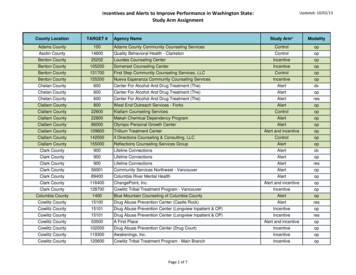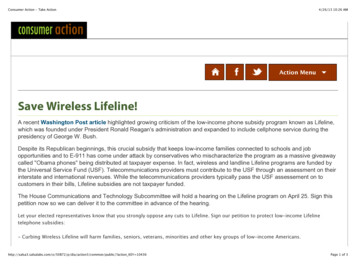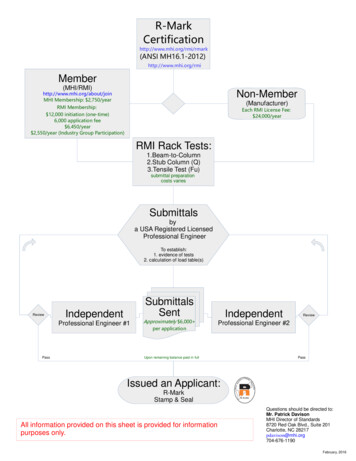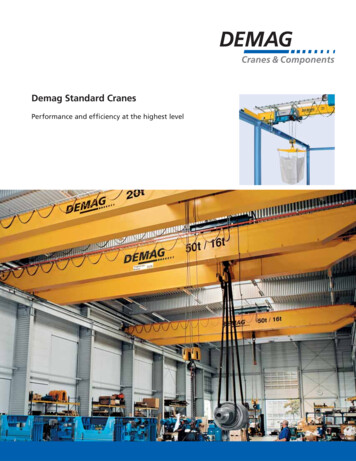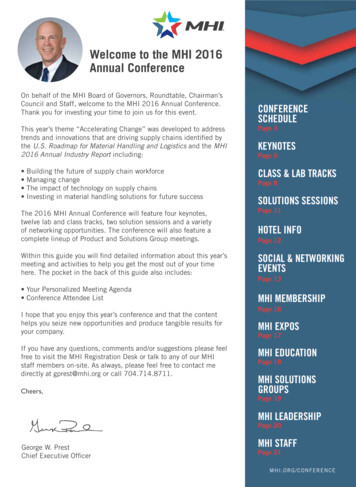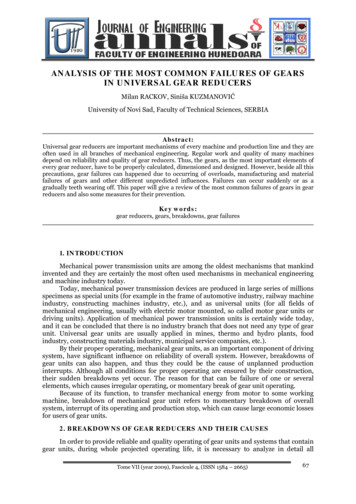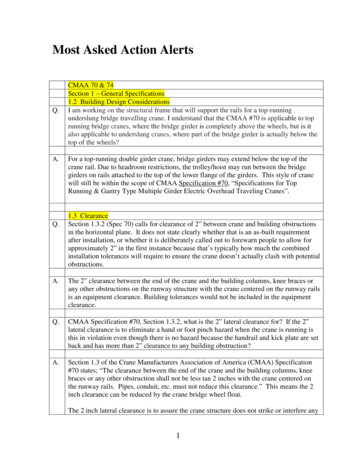
Transcription
Most Asked Action AlertsQ.A.Q.CMAA 70 & 74Section 1 – General Specifications1.2 Building Design ConsiderationsI am working on the structural frame that will support the rails for a top-runningunderslung bridge travelling crane. I understand that the CMAA #70 is applicable to toprunning bridge cranes, where the bridge girder is completely above the wheels, but is italso applicable to underslung cranes, where part of the bridge girder is actually below thetop of the wheels?For a top-running double girder crane, bridge girders may extend below the top of thecrane rail. Due to headroom restrictions, the trolley/hoist may run between the bridgegirders on rails attached to the top of the lower flange of the girders. This style of cranewill still be within the scope of CMAA Specification #70, “Specifications for TopRunning & Gantry Type Multiple Girder Electric Overhead Traveling Cranes”.1.3 ClearanceSection 1.3.2 (Spec 70) calls for clearance of 2” between crane and building obstructionsin the horizontal plane. It does not state clearly whether that is an as-built requirementafter installation, or whether it is deliberately called out to forewarn people to allow forapproximately 2” in the first instance because that’s typically how much the combinedinstallation tolerances will require to ensure the crane doesn’t actually clash with potentialobstructions.A.The 2” clearance between the end of the crane and the building columns, knee braces orany other obstructions on the runway structure with the crane centered on the runway railsis an equipment clearance. Building tolerances would not be included in the equipmentclearance.Q.CMAA Specification #70, Section 1.3.2, what is the 2” lateral clearance for? If the 2”lateral clearance is to eliminate a hand or foot pinch hazard when the crane is running isthis in violation even though there is no hazard because the handrail and kick plate are setback and has more than 2” clearance to any building obstruction?A.Section 1.3 of the Crane Manufacturers Association of America (CMAA) Specification#70 states; “The clearance between the end of the crane and the building columns, kneebraces or any other obstruction shall not be less tan 2 inches with the crane centered onthe runway rails. Pipes, conduit, etc. must not reduce this clearance.” This means the 2inch clearance can be reduced by the crane bridge wheel float.The 2 inch lateral clearance is to assure the crane structure does not strike or interfere any1
obstruction on the building as the crane travels down the runway system. This clearanceis considered on equipment clearance.Please contact OSHA if you need an interpretation to the requirements listed under1910.179 (b)(6)(i).Q.Does Spec #70 – 1994 state the minimum clearance distance between the end truck railand the bottom of the end truck? That is ½” for an 8” diameter wheel, 5/8” for a 12”diameter wheel, etc. You stated that the 1994 edition has been replaced. What aboutcranes that are manufactured, delivered, and installed under the 1994 edition.A.The CMAA Specifications do not identify minimum clearance requirements between thetop of end truck rail and the bottom of the end truck structure.Cranes built to an earlier CMAA Specification are “Grandfathered”.1.4 RunwayAre there any special provisions that can be employed for situations which require a gapgreater than the standard 1/16” between rails?Q.A.CMAA Specification 70 and 74 Revised 2004, Paragraph 1.4.2 (#70), 1.4.1.1.3 (#74) and1.4.1.2.2. (#74) limit the gap between runway rails to 1/16”.I would recommend that you minimize any gap in the runway or bridge rail. Minimizingthe gap at the joints will extend the life of your crane wheels.Q.In Section 1.4.2, the standard specifies that rail joint separation should not exceed 1/16in. It seems as though this should be allowed to vary with temperature or that larger gapsshould be allowable for larger wheel sizes. Is this 1/16 in really the required gap at alltemperatures and for all rail sizes?”A.Crane rails expand/contract uniformly, temperature expansion is accounted for at theends of the entire runway rail. The gaps between individual rail sections should be assmall as possible, or even welded with zero gap so as to avoid shock loading to cranewheel bearings and wearing of the joint edges.Q.We have a crane that we are looking at replacing the crane rail, but really cannotdetermine how bad we are. Does CMAA crane rail tolerance apply to ground rails as wellas overhead crane rails and are the tolerances for new cranes any different than a cranethat has been in operation for several years.A.Section 1.4 and related Table 1.4.2-1 of CMAA Specification 70 address requiredoverhead crane runway rail tolerances. Maintaining these tolerances is recommendedthroughout the crane’s operating life.Section 1.4.6 states, “Gantry and other types of cranes may require additionalconsiderations”. These considerations should be discussed with the cranemanufacturer.2
Q.Does Spec 70 and Spec 74 address grinding on Crane Rail?A.CMAA Specification #70 Paragraph 1.4.2 and Specification #74 Paragraphs 1.4.1.1.3 and1.4.1.2.2 limits the gap between runway rails to 1/16”. Neither specification addressesbridge rails for the trolley. However, I would recommend that you do not exceed 1/16” ineither case.I would also recommend that you minimize any gap in the runway or the bridge rail.Minimizing the gap at the joints will extend the life of your crane wheels.Grinding the ends of the rail is a method available to minimize the gap at the jointbetween rails. Another method is to eliminate the joints in the runway of bridge rail.Flash butt welding is one method used to weld the ends of the rail together to eliminateany joints.If you are grinding the rails as a method of repair, grinding of rails is not a normalprocedure and therefore not addressed by the CMAA Specifications. Misalignment ofsuch rails on equipment that has been in service may be an indication of some otheralignment or structural problems. The OEM or crane service/maintenance companyshould review such occurrences.Q.Spec 70, Table 1.4.2-1 – CMAA Crane Rail Tolerance: I understand the “maximum rateof change” (1/4” in 20’0”) but I am not clear on the “overall tolerance”. Are thesetolerances over the length of the whole runway? Please explain how these tolerances areapplied.A.CMAA Specification #70, Revised 2000, Table 1.4.2-1 is a guideline for crane runwayrail tolerances. The overall tolerance is the maximum deviation ( or -) allowed for theentire length of the runway rail.For example:If a runway is 75’-0” span, the allowable measured runway rail span deviation would be74’-11¾” to 75’-0¼”.For straightness, each rail can be plus or minus 3/8”off of center.The runway must meet both criteria. You could measure a minus 3/8” straightnessdeviation on each rail and be within the straightness tolerance. If the minus 3/8” is at thesame point at each runway rail, the runway rail span would measure 74’-11¼”. 74’-11¼”does not meet the minimum of 74’-11¾” for runway rail span and adjustments wouldhave to be made to the runway.Rail to rail elevation and rail elevation must also be worked together as described above.Q.CMAA Spec #74, Revised 2000, Paragraph 1.4.1.1.4 discusses lateral deflection of3
runways for top-running cranes. Am I assuming correctly that “without impact” refersonly to the determination of a design load based upon which the calculated lateraldeflection should not exceed L/400?A.You are correct; the design load for which the lateral deflection is calculated is 10% ofthe maximum wheel load without VIF (Vertical Inertia Forces) or impact.Q.Is the lateral deflection limited to L/400 for all forces developed by the crane, includingimpact, within its rated load?A.No Forces other than 10% of the maximum wheel load without VIF, such as forcesrelated to trolley accelerations, are not considered for this load case. Other load cases forwhich the runway is designed, such as the UBC (Univeral Building Code) or AISC(American Institute of Steel Construction) specifications, may consider other cases.Q.In Specification #70, section 1.4 Runway, you give tolerances for runway railsinstallation. After a number of years, those tolerances are not respected anymore. Doyou have information on what criteria would be acceptable for rails for old runways?A.The runway rails shall be straight, parallel, level and at the same elevation. The distance,center to center and the elevation shall be within the tolerances given in Table 1.4.2-1.These tolerances shall not be compromised based on new or old rail or the age of therunway system.Q.Our issue is with a single girder, top running, 10 ton crane newly installed. The 30 lbrails are offset the vertical web of the railway girder by 1.5 inch – about the width ofthe30 lb. Rail. Attempts have been made to justify the soundness of this offset byreferring Spec 74, section 1.4.1.1.1.4 (railway deflection). Are there more specificGuidelines for this type of deflections?A.Please refer to Table 1.4.1-1 of CMAA Specification #74, Revised 2000. If you reviewthe straightness category, one could assume that the centerline shown is the same as thecenterline of the web. You would then only be allowed a maximum offset from thecenter of the web of 0.375 inches.Q.A.Section 1.4.1.1.4 of Specification #74 is meant to address simple lateral and verticaldeflections and not torsional deflection due to eccentric loading conditionsWe have three runway beams made of welded steel plate supporting a 7.5 ton underrunning crane. The beams has to be made according CMAA 74 specification. Wemeasure a tilt of the bottom flange of ¼”. The Article 1.4.1.2.1 of CMAA 74 says: “thewheel running surface shall have no transverse tilt. But the table 1.4.1.1 give a toleranceof ¼” on elevation. Also the code for structural element give ¼” for fabrication tolerance.Is it possible to accept the tilt and still be according to the CMAA-74 tolerance?CMAA Specification # 74, Revised 2000, paragraph 1.4.1.2.1 states that there is to be notransverse tilt in the lower flange. This is required so each wheel is loaded uniformly. If4
the wheel assembly is only loaded on one side, the load doubles on that one wheel. Thisin turn will overload the axle, wheel bearings, truck structure, etc. Typically, the wheelassembly and end truck are not designed to withstand this type of loading.CMAA Specification # 74, Revised 2000, Table 1.4.1-1, Elevation, deals with the runwayas a whole and does not pertain to the lower flange in isolationThe CMAA cannot comment on other specifications, but it is important to remember thatspecifications have to apply to the application and situation.According to the CMAA, the tilt of the bottom flange of ¼” is an unacceptable conditionQ.Is the “Maximum Rate of Change” criteria (per CMAA 70, Table 1.4.2.1 and CMAA 74,Table 1.4.1.1) defined as a maximum gradient tolerance (i.e. slope not to exceed .012” in1 ft) or as a dimensional tolerance zone (i.e. over any 20’ distance the measurements mustbe within a ¼” tolerance zone)?A.Table 1.4.2.1 in CMAA Specification #70 and table 1.4.1.1 in specification #74 indicatesthe maximum rate of change is ¼” between two points that are 20 feet apart. It is notmeant to check variances every footQWhat is the definition of Lr in Section 1.4.3 of CMAA Spec #70?A.The definition of Lr in section 1.4.3 CMAA Spec #70 is the runway girder span beingevaluated or the distance between runway support columns. As stated in section 1.4.3,“The lateral deflection should not exceed Lr /400 based on 10 percent of the maximumwheel load(s) without VIF”.Q.On Page 7 (CMAA Spec#74), section 1.4.1.2.3, it shows the vertical delection should notexceed Lr/450 based on maximum wheel load(s) without VIF. Can you explain what Lrand VIF stand for? On page 20, it shows that L unbraced length of compressionmember, and the r radius of gyration of member. How do I determine each of theseitems?A.In CMAA Specification #74, Revised 2000, Paragraph 1.4.1.2.3, Lr is the distancebetween runway supports and is indicated in the top Figure in Table 1.4.1-1. VIF standsfor “Vertical Inertia Force”. VIF, as it applies to crane design, is described in Paragraph3.3.2.1.1.4.In Paragraph 3.4.6.3, L unbraced length of the compression member or to put it anotherway, the length of the member subject to compression that is not restrained to resistbuckling in the member.In Paragraph 3.4.6.3, r the radius of gyration of the member. “r” is determined by eitherclassical methods or if you have a standard beam section, there are various publicationswith “r” determined.5
You can find additional information about buckling and radius of gyration in moststrength of materials books or machine design books.An additional resource for standard beams is the AISE (American Institute of SteelConstruction) “Steel Construction” manual.Q.Section 1.4 of Spec 70 and 74 give deflection limits for the crane runway beams. Thevertical limit being Lr/600. For an eighty foot span the limit would be 1.6 inches. Table1.4.2-1 gives much tighter tolerances for the distance between rails, rail straightness andrail elevation both longitudinally and differentially between rails. The tworecommendations conflict significantly unless Table 1.4.2-1 is referring to an unloadedcrane rail.A.The recommendations of Table 1.4.2-1 in CMAA Specification #70 and#74, are inreference to the crane runway rails prior to crane erection. Therefore, therecommendations are for unloaded (ie. Without crane dead weight or live load) runwaysystems.Q.Concerning CMAA 74 Section1.4 and Table 1.4.1-1 for the straightness and elevationoverall tolerance, "B" and "C" is stated as 3/8" which would means 3/4" total overall.Can this requirement be revised to a tighter tolerance; say 3/16" and 3/8" total overall,and still be within conformance to CMAA regulations/requirements? Would this thenrequire a change to the values shown in the 'Max
21.12.1995 · A. CMAA Specification # 74, Revised 2000, paragraph 1.4.1.2.1 states that there is to be no transverse tilt in the lower flange. This is required so each wheel is loaded uniformly.
